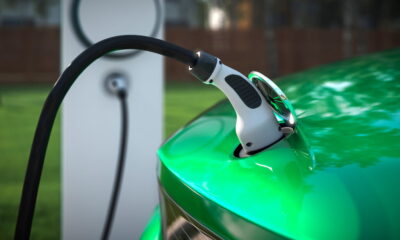

Energy
How Your Family Can Easily Transition to a Greener Life
Regardless of what Kermit may say, being green is a lot easier than you might think. The key to making a successful transition to living green is to do it in small steps — or as Kermit would say, by taking “tadpole hops.” If you set monthly goals for you and your family to take one step toward living a totally green life, it will be no problem to master.
Here are some suggestions on how you can make the change:
1. Clean Green
Whether you clean daily or just once a week, there are options for natural cleaners that will not only make you Martha Stewart’s best friend, but will also be better for you and the planet. There are manufactured products, such as Method, that make biodegradable, naturally derived, and non-toxic household cleaners, laundry soaps and more.
If you don’t have time to run to the store, you probably already have what you need at home to make your own cleaners. You can just do quick search on Pinterest and find a variety of natural cleaning options.
2. Shop Green
You might already savvy at bringing your own bags to the grocery store, but if not, this is the one of the easiest ways to start going green. Most large grocery chains now offer reusable shopping bags, or you can purchase them from a variety of websites.
Because they are bigger than plastic bags, you can put more in them, likely reducing the number of trips needed to unload. These bags also often make attractive choices for storing your items for activities like a trip to the beach or even as a gift bag.
Additionally, if you do have a bunch of plastic grocery bags sitting at home, don’t throw them out. Check to see if there is a drop-off at the store for you to recycle them.
3. Drive Green
When it comes to alternative fuels for cars, the options that will be available in the next decade are incredible. Gasoline will remain the most expensive and available alternative, at least in the short term, but it will soon be left behind by biodiesel, methanol, ethanol, compressed natural gas, hydrogen and electricity. In 2012, Americans used 13% less gas — more than 15.9 billion gallons less, than they had in 2007 because of the availability of alternative fuels.
4. Eat Green
Literally and figuratively, this is one of the healthiest suggestions for going green. Consider starting a garden, either in your yard or as part of a community garden, and grow your own fruits and vegetables. You can be sure your garden isn’t sprayed with dangerous chemicals. Also, if everyone grew a garden, there would be fewer large trucks on the road using gasoline and emitting pollutants to deliver vegetables and fruits to grocery stores.
If you don’t have space for a garden and can’t find a community one near you, consider looking for local farmer’s markets in your area.
5. Dress Green
You don’t necessarily have to dress in green, but be aware of where your clothing is made and from what materials. Buying clothes that are made in your own country reduces the number of times products will need to be flown or shipped in from outside the country. It also provides stateside jobs while at the same time reducing the sweatshop and the underage, underpaid jobs from outsourced clothing manufacturers. It increases the economic purchasing power for the country, too.
Dressing and shopping green also means buying from companies that practice good corporate social responsibility and are mindful of reducing the amount of chemicals and toxic waste they use and generate.
6. Unwind Green
Choose one long weekend a month, from the end of your business day on Friday to the moment you walk in the office on Monday to disconnect from all social media, telephones and televisions. Turn the computers and tablets off and get outside. Go for a walk, a picnic or a bicycle ride. Go watch the kids in Little League play baseball even if you don’t have a kid on the team. No matter what you decide to do, just do it outside.
7. Recycle Green
Recycling is more than just turning in plastic, aluminum and glass. Recycling green also means changing the way you use and purchase those items. For example, instead of getting a paper or Styrofoam coffee cup at your favorite coffee shop drive-thru in the morning, make your own coffee or ask if they will fill your own reusable plastic or glass thermos. Bring a coffee mug from home to use for the office coffee bar. Do you get soda drinks on the go at lunch? Bring your own reusable tumbler.
8. Water Green
Whether you live in a tropical rainforest, or in the desert, there are ways you can both recycle water or use it in a green fashion. This includes harvesting rainwater, showering and washing clothes less often. You can also use the drain-off from washing laundry to water your lawn and gardens.
Additionally, you might want to consider incorporating drought-resistant plants into your landscaping designs and use a hoop or greenhouse for your garden plants so they won’t lose as much water to evaporation.
Living green can be easier than you expect when you take small steps. The options are limitless.

Bobbi Peterson loves writing and regularly posts on her blog Living Life Green. She’s also a freelance writer, green living advocate and environmentalist. You can find more from Bobbi on Twitter.






























